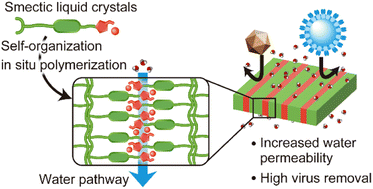Development of liquid-crystalline smectic nanoporous membranes for the removal of SARS-CoV-2 and waterborne viruses†
Abstract
Obtaining safe and affordable water free from bio-contaminants is a critical global issue. Filtration using polymer membranes with nanopores is a significant method for water purification. Here, we demonstrate the fabrication of water-treatment membranes with ordered nanochannels, exhibiting significant virus removal properties, by fixing the assembled structures of ionic liquid-crystalline molecules via photopolymerization. Nanostructured water-permeable membranes are prepared from ionic liquid-crystalline smectic compounds composed of a rod-shaped rigid core to form two-dimensional nanochannels. The removal of viruses, including inactivated SARS-CoV-2, in a virus cocktail solution is investigated. Tuning of the smectic assembled structures is discussed from the perspective of self-assembled molecular structures. In addition, the effects of the ionic channel morphology on water permeability are examined.

- This article is part of the themed collection: Celebrating the scientific accomplishments of RSC Fellows


 Please wait while we load your content...
Please wait while we load your content...